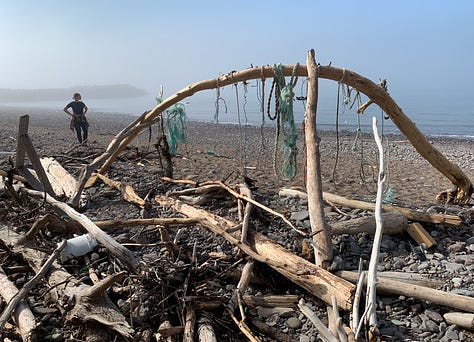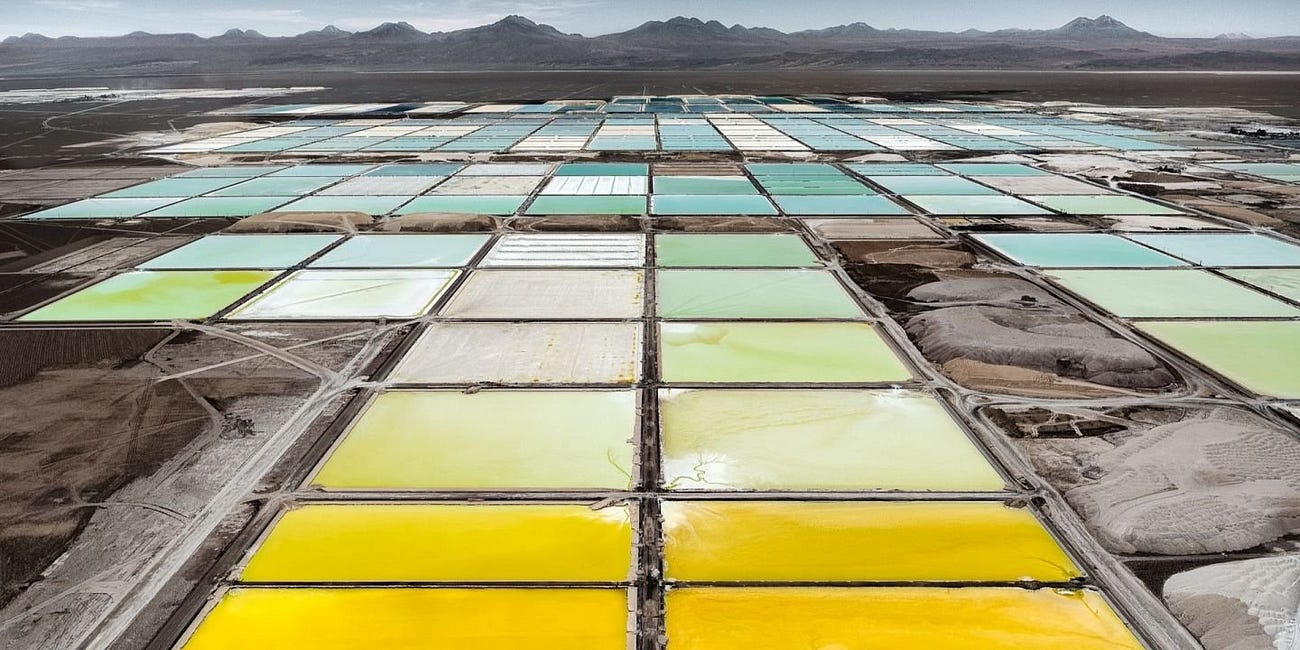Digging Ourselves Into a Hole: The Predictable Scam of Rural Resource Hype
Advancemen, Economics, and the Grinding Inevitable Predictability of How All This Works Out. Why Chasing Resource Riches Is the Past, Not the Plan

Yes!!! For sure. We should always be open to talking about our opportunities, new ideas and technologies, new ways of looking at things, and changing our minds when the facts change.
Let's talk it through based on all the cool new gear, known data, financial markets, global experience, our own history, economics, and the future of the woods and waters we love.
Let's open the discussion on Natural Resource "Development" in Nova Scotia!
I’ll start.
I guess I’m going to just swing at every ball Sean Kirby and the folks at the Mining Association of Nova Scotia pitch. I can’t help myself. This week’s talk of uranium mining gave me atomic ache.
But the essays will get shorter because they’re all the same - Fracking, Lithium, and now Uranium today. Antimony. Cobalt. Copper. Graphite. Hydrogen. By the time we come full circle and get back to coal and gold, the essays will just be cut and paste and we can all sing the chorus together.
Oh, about all that cool new gear…
The gold rush drew thousands, each dreaming of fortune, but most found only backbreaking labor and empty pans. The real winners? The ones selling shovels, picks, and supplies—profiting steadily while others gambled on luck. In the end, it wasn’t gold that made men rich, but the certainty of selling what every dreamer needed.
Think of the Children!
In the 1964 Disney film Mary Poppins, when the character of Mrs. Banks pleaded with her departing nanny not to quit and to "think of the children!" the phrase was popularized as a satiric reference. The appeal's subsequent use is often the subject of mockery.
But I’d like to return to a more serious consideration of the phrase. I take it to mean just thinking about the long-term and broad impacts of a course of action rather than the narrow and immediate. Human society is definitely at its best when it does think of the children - the rising generation as yet unborn and the shape of things to come. We are at our best when we think about care and stewardship with some sense of destiny, and when we think long-term. That’s indisputable and uncontroversial. So let’s use that as the foundational building block for these resource extraction discussions.
Resource extraction—at its worst—is the epitome of the short-termist’s mindset. It is the philosophy of the disconnected man, the man who sees the earth not as something to steward for future generations but as a storehouse to plunder for personal and immediate gain.
The Moral Bankruptcy of Resource Extraction
To dig into the ground, extract what is valuable, and sell it off until nothing remains is not a strategy of builders, nor of those truly invested in the shape of things to come. It is the act of men who assume their fortune justifies the correctness of their actions. But prosperity built on depletion is not prosperity at all—it is a brief, hollow moment of affluence bought at the expense of those yet to be born.
It’s a Cartoon We’ve All Seen Many Times
We’ve all seen this story before—on the news, in history books, and even on TV as a tired trope. A struggling rural town, a flashy promise of wealth, and a handful of well-connected insiders who make it all happen.
In Nova Scotia, the resource extraction cycle isn’t some organic economic shift; it’s a script written by the politically connected and a few traveling advancemen, grifters from big mining firms. They show up like clockwork, manufacturing urgency, selling the idea that digging up the land is the only way forward, despite decades of evidence proving otherwise. They prey on economic desperation, cozying up to politicians, and pitching short-term job booms as the magic bullet for long-standing struggles.
The playbook is predictable: hype builds, government leaders fall in line, and extraction starts with grand speeches about revitalization. Then, the market shifts, the companies pull out, and all that’s left is poisoned land, dried-up towns, and the empty echoes of broken promises.
Today the smell is still lingering at the pulp mill and the stinking cost of the cleanup will linger even longer. We gotta take another whiff and remember.
The aftermath is always treated as an unfortunate accident, not the inevitable outcome of short-term thinking. Until rural regions break free from this rigged cycle and invest in industries that last—advanced manufacturing, renewable energy, technology, sustainable agriculture—they’ll keep getting played, repeating the same old story that only ever makes the rich richer and leaves everyone else covered with dirt and regret.
THE ADVANCEMAN
If we’re going to do this again, I want to at least make you aware of one term, one job.
An advanceman is a person who goes ahead of a main group—whether in politics, business, or entertainment—to prepare the ground, set the stage, and create favorable conditions for whatever is coming next. Historically, in traveling shows like circuses or vaudeville, an advanceman would visit towns in advance to put up posters, book venues, and drum up excitement before the main event arrived.
The Role in Mining & Resource Extraction:
In the context of mining and resource extraction, advancemen are often the first wave of a corporate PR campaign, arriving in rural areas to sell the dream of jobs and prosperity. They court local officials, hold community meetings, and attempt to win over skeptical residents before heavy machinery ever touches the ground.
While they present themselves as friendly and informative, they often soften opposition and shape the narrative before concerns about environmental impact, economic viability, or corporate accountability can fully take root.
In short: an advanceman is a professional persuader, a scout who lays the groundwork for what’s coming next—whether that’s a carnival on the edge of town or a controversial new mining project.
Against Uranium Mining: The Case for Prosperity Beyond Resources
Nova Scotia stands at a crossroads, staring down the barrel of yet another short-sighted resource extraction dream. Uranium mining—like so many other ill-fated ventures before it—tempts with the promise of economic transformation, but history and logic tell a different story. The reality? Commodities are a fool’s game, a boom-and-bust cycle that shackles a region to global market whims rather than empowering it with self-sufficiency, resilience, and lasting prosperity.
The False Promise of Uranium Mining
The current global demand for uranium is about 67,000 tonnes per year. The vast majority of uranium production is dedicated to fueling nuclear power plants, with a small fraction utilized for military purposes and an even smaller amount for medical applications.
Yes, uranium prices are rising. Yes, global supply chains are potentially shifting. But will this bring sustainable wealth to Nova Scotia? No. The uranium market is controlled by massive, established players with decades of infrastructure, regulatory experience, and proven reserves. Saskatchewan already dominates the world and Canada’s uranium sector, and even its producers struggle with fluctuating prices and regulatory hurdles. Existing Saskatchewan mine operations can produce all the uranium that Canada would ever need, and a good portion of the world’s supply.
Nova Scotia, with its limited known reserves, environmental sensitivities, and complete lack of uranium mining expertise, is poised to be nothing more than a bit player in a high-risk, low-reward industry that literally has the potential for global mass destruction. The province does not have the geological advantages of Saskatchewan or Kazakhstan. Even if deposits exist, Nova Scotia would face an uphill battle against community opposition, regulatory complexity, and capital-intensive startup costs. In short, the chances of uranium mining transforming Nova Scotia’s economy are slim to none.
Breaking Free from the Commodities Trap
It’s time to stop playing the serf in the global resource economy—fighting over the right to scrape value from the land like medieval peasants toiling in exhausted fields of mud. Resource dependency is a dead-end road. The path to prosperity lies in adding value, in processing raw materials rather than simply extracting them and shipping them elsewhere for profit.
Look around the world: economies that thrive do so not by clinging to unstable commodities markets but by building industries that create, innovate, and refine. Nova Scotia has the opportunity to invest in sectors that generate real wealth—technology, advanced manufacturing, sustainable fisheries, high-value agriculture, and renewable energy. These industries do not just create jobs; they create economic ecosystems that drive long-term stability, intellectual capital, and regional self-sufficiency.
The Smarter Bet for Nova Scotia
The province’s land, labor, and capital are finite resources. Why waste them on yet another extractive industry when they could be channeled into ventures that offer sustainable prosperity? Why fight for a seat at a table where others already feast when we could build our own?
Instead of uranium mining, Nova Scotia should be:
Investing in Renewable Energy: Harnessing wind, tidal, and solar power not just for local consumption but for export.
Building High-Value Manufacturing: Processing raw materials here at home rather than shipping them out for pennies on the dollar.
Expanding the Knowledge Economy: Focusing on technology, research, and education to create an economy based on intellect, not just natural resources.
Strengthening Local Food Systems: A booming agricultural and aquaculture sector would not only boost self-sufficiency but also generate high-quality exports.
Nova Scotia’s future should not be defined by a desperate grasp at dwindling resource wealth. The province has been burned before by resource-driven economic mirages, and it’s time to step out of the cycle. Instead of uranium mines, let’s build an economy that actually works for Nova Scotians—one that creates sustainable industries, lasting prosperity, and a future built on innovation rather than extraction.
Ultimately, more than the means, it is the hope itself, belief in a better future, that sparks the economy, cheers the people, and brightens the way.
Uranium mining is the past. It’s time for Nova Scotia to choose the future.
Let’s Have Some Sense Of Destiny
Suppose Nova Scotia—or any rural region—stood at the threshold of its destiny and was asked to chart a course for the next 100 years. Would it choose to dig holes in the earth and sell its finite resources on a commodity market controlled by derivative trading (financial weapons of mass destruction) until there was nothing left? Would it tie its fate to the profitless whims of the commodities market, forever at the mercy of global prices set in faraway boardrooms? No region with an ounce of self-respect or foresight would make such a choice.
The Fool’s Bargain of Resource Extraction
Resource extraction is not development. It is liquidation. It is the slow, grim process of converting a place’s natural wealth into temporary revenue and unintended consequences—leaving behind poisoned lands, broken economies, and communities abandoned when the last ounce of value has been dug out and carried away. The promise of uranium, gold, or any mineral is always the same: short-term jobs, investor profits, and a distant, ever-elusive “boom” that always, eventually, turns into a bust.
Look at a map of the world. It’s easily divided into places the are victim of resource extraction and places where capitalism has processed and added value to things. For sure the two are related and must be carefully balanced. It is when the two are separated by grifters, hucksters, and pitchmen that we see the worst of both sides of the equation.
History is littered with the carcasses of places that fell for this mirage. The Nova Scotia coal towns, the deforested landscapes of Newfoundland, the spent oil fields of the west—each a cautionary tale, each a warning that digging for dollars never builds a lasting economy.
The Myth of the “Natural Resources Economy”
The very term is a lie. There is no “natural resources economy” that leads to prosperity—there is only the resource extraction economy, a system that takes wealth out of a place rather than building it within. The regions that thrive do not merely extract; they innovate, they manufacture, they refine, they create.
The Resource grifters and their industrial machine does not come to “Invest” in rural regions any more than a Walmart or Dodge dealership does. They come, and this should really be obvious to everyone - to extract every dollar of wealth we create.
Consider the stark contrast between an economy built on raw extraction and one built on value creation:
Norway’s oil wealth funds innovation, education, and infrastructure—while Alberta’s boom-bust cycle leaves empty office towers and fiscal crises.
Germany mines no rare earth metals, yet dominates global auto manufacturing—while Congo, rich in minerals, remains trapped in economic despair.
Japan lacks natural resources, yet leads the world in high-tech industries—while Venezuela, drowning in oil, suffers in economic ruin.
The message is clear: wealth is not in what a region takes from the earth, but in what it makes from it.
A Future Worth Building
If Nova Scotia wants to be prosperous a century from now, it must look beyond the digger and the drill. It must build industries that are resilient, self-sufficient, and capable of withstanding the storms of global markets. That means:
Investing in Renewable Energy – The world is moving away from fossil fuels. Wind, tidal, and solar power can turn Nova Scotia into an energy exporter without poisoning the land.
Building a Knowledge Economy – Research, innovation, and education create industries that thrive long after the last mine has closed.
Revitalizing Manufacturing – Processing raw materials into valuable products keeps wealth and jobs within the province.
Strengthening Food Security – Investing in sustainable agriculture and aquaculture ensures long-term economic and ecological stability.
A Choice Between Progress and Desperation
The path forward is not dictated by geology but by vision. Resource extraction is not a strategy—it is an act of desperation, a surrender to the idea that a region’s only value is in what can be taken from it.
Nova Scotia can do better. It must do better. It must choose to build, create, and innovate, rather than simply sell off its future, one truckload of ore at a time.
Let other places strip their land bare in the vain hope of striking it rich. Let Nova Scotia rise above, choosing industry over extraction, progress over plunder, and a future that is defined not by what it loses, but by what it builds.






RELATED:
WTF - What The Frack?
Fracking, short for hydraulic fracturing, is the process of using a high-pressure mix of water, sand, and chemicals to release oil and gas from deep underground. Now, you might be thinking, “How bad can fracking really be? It produces natural gas! That sounds natural enough.”
Should Nova Scotia Invest in Lithium Mining?
Lithium Mining in Nova Scotia - A Brief (that’s actually brief) Investment Perspective For Discussion
RELATED - SOLUTIONS:
It's Not Capitalism That's Bad - It's That We're Bad Capitalists
Let’s put it bluntly: Nova Scotia has a choice. We can either continue as the economic colony we’ve been for centuries—digging, cutting, and hauling away our raw materials for others to process and profit from—or we can step into the future, creating wealth here at home by adding value to what we produce.










I was talking to a friend about this and he told me about the Everwind Green Hydrogen and Ammonia project and its First Nations equity partners. Seems like a progressive project and great example of investing in renewable energy. Thoughts?
https://everwindfuels.com/point_tupper_economic_infographic.pdf
My hero, ( I'm so annoyed that you say it so much better than I), really John, simply a stunningly accurate assessment of our immediate government pro-extraction situation...and for all time.
I would only add that the wind-to-electricity-to-hydrogen-to-ammonia play is also dependent on extraction as it is really a wind-to-electricity-to-WATER-to-hydrogen-to-ammonia process...millions of litres of NS potable water per day extraction (the water never comes back into our watershed). Also the case for the whole process, (including shipping to Europe & return), being a green process, remains highly questionable. Our previous laudable goal of getting us off coal should remain the priority in developing our renewable energy infrastructure.